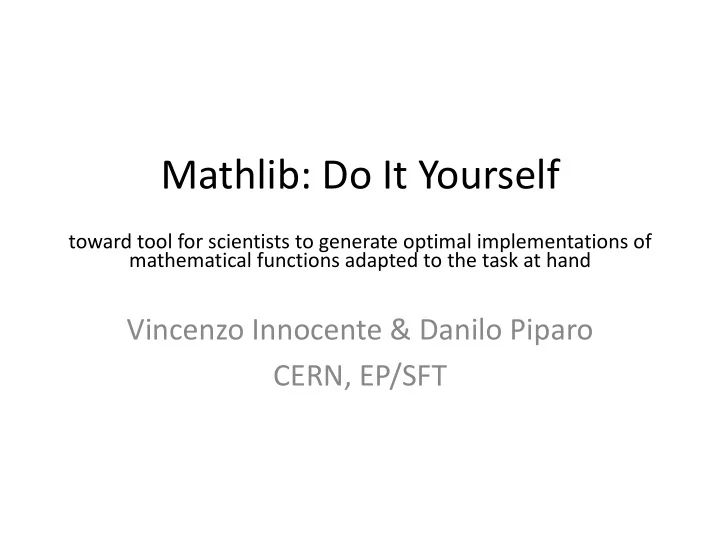

Mathlib: Do It Yourself toward tool for scientists to generate optimal implementations of mathematical functions adapted to the task at hand Vincenzo Innocente & Danilo Piparo CERN, EP/SFT
Motivation • Scientists and engineers have the need to implement mathematical functions that best fit their needs – Precision, validity range – Target architecture (different vectorization, etc) – Environment and language • Our goal is to provide a tool for scientists integrated into the analysis eco-system deployed in HEP in particular as provided by CERN 3/9/18 VI metalibm 2
Strategy • Provide a layered tool that allows the development and implementation of mathematical functions tailored to a specified need • Integrate it in the CERN standard analysis eco- system • Make it available into the “cloud” 3/9/18 VI metalibm 3
Implementation • With the collaboration of the CERN/SFT “Packages & Releases project” we have integrated Sollya, its dependencies and its python interface into the standard CERN software distribution – This makes Sollya and eventually MetaLibm available ubiquitously on the Cloud • We have developed a set of “jupyter” notebook that provide examples of use including generation of python and C code 3/9/18 VI metalibm 4
Addressing Heterogeneity • One of the main challenge of Cloud computing is the ability to adapt to any computation environment notably exploiting a large variety of computing architecture • Our strategy is to use standard compiler technology to build multi-target libraries and to rely on compiler optimization (in particular auto-vectorization) to produce the best code for each target • We prefer pre-compiled libraries to Jit-technologies as the former can be fully tested and validated before deployment and will not depend on details of the running environment. • Porting to GPU (cuda) proven to be trivial at least as device functions (easy to achieve bitwise compatibility as well) – Still not obvious how to build reusable efficient kernels as data copy may easily dominates 3/9/18 VI metalibm 5
Reproducibility • No FMA, no problem – C/C++ up to O3 guarantee full bitwise reproducibility across IEEE754 compliant architectures (including x86_64, arm, PC, GPUs) • FMA: no standard re-association rules – Only solution to date is to force no re-association and use explicitely std::fma • Need to teach code generators to properly use std::fma (or equivalent macro) 3/9/18 VI metalibm 6
Deployment • CERN is working on next generation analysis eco- system • Its portal will most probably be “SWAN”: Service for Web-based data Analysis – https://swan.web.cern.ch • SWAN is therefore the natural environment where our tool will be run • It will provide a twofold use – Generation of optimized mathematical function using Sollya and MetaLibm – Their integration in the analysis eco-system through a direct, optimized numpy binding 3/9/18 VI metalibm 7
Workflow Test and Generation of Generation of Validation python and C Math functions implementation Use in daily Analysis work Generation of Multi- target C library and of numpy binding Use in offline application 3/9/18 VI metalibm 8
Status • Sollya fully integrated in CERN environment – Tested under SWAN • Examples as jupyter notebook produced – http://test-innocent.web.cern.ch/test- innocent/MetaLibm/ – Some components may be packaged as standalone python modules • Multi-target library and full numpy binding released for VDT – https://github.com/dpiparo/vdt/blob/master/progs/n umpyBootstrap.csh 3/9/18 VI metalibm 9
Recommend
More recommend